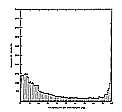IRAS Explanatory Supplement
VII. Analysis of Processing
D. Photometric Accuracy
D.3 Variable Sources
Table of Contents | Index | Previous Section | Next Section
 |
|
Figure VII.D.9 HCON-to-HCON flux variations at 12 and 25 µm, normalized
with respect to the resultant HCON uncertainty. larger largest |
Table VII.D.4 gives the approximate relative change in the
flux densities at 12 and 25 µm associated with a given probability of
variability. Two values are given, one for bright sources and one for faint
sources. The table shows that there is a strong increase in the observed
relative flux change as the quoted probability of variability increases from
90 to 99%. It is seen that variable sources whose fluxes change by 20% or
more at 12 and 25 µm canbe identified reliably. A caution is
necessary, however. In regions of high source density, scan-to-scan
variations in the baseline can affect the measurements enough to produce
spurious indications of variability.
| Probability of Variability | Bright Sources | Faint Sources |
|---|---|---|
| 0.50 | 10% | 15% |
| 0.75 | 15% | 20% |
| 0.90 | 20% | 30% |
| 0.99 | 30% | 40% |
 |
|
Figure VII.D.10 A histogram showing the number of sources with
a given probability of variability. larger largest |
Figure VII.D.10 shows the distribution in number of sourcesvs. probability of variability quoted in the catalog. Twenty-five percent of eligible sources have a probability of variability greater than 50%; 13% have a probability of variability above 90%. Sources with a high probability of variability preferentially vary on a long time scale with roughly ten times as many sources varying over a time scale of 6 months as on time scales of weeks.
Figure VII.Ap.16 shows the distribution
on the sky of sources flagged with a probability of variability of 0.9 or
greater. The plot clearly shows a population of sources occupying a region
near the center of the Galaxy, probably due to a population of highly
variable sources in the Galactic bulge. In the Galactic plane at Galactic
longitude 320°, there is a diagonal edge showing a marked increase in the
density of variable sources. This, as well as other more subtle structures,
is probably a sampling effect since in this region the source density is high
and the survey strategy produced extra HCONs at time intervals suitable for
detecting variability. This same effect is also seen in the Large Magellanic
Cloud, which because it was at the south ecliptic pole received many
coverages.
Table of Contents | Index | Previous Section | Next Section